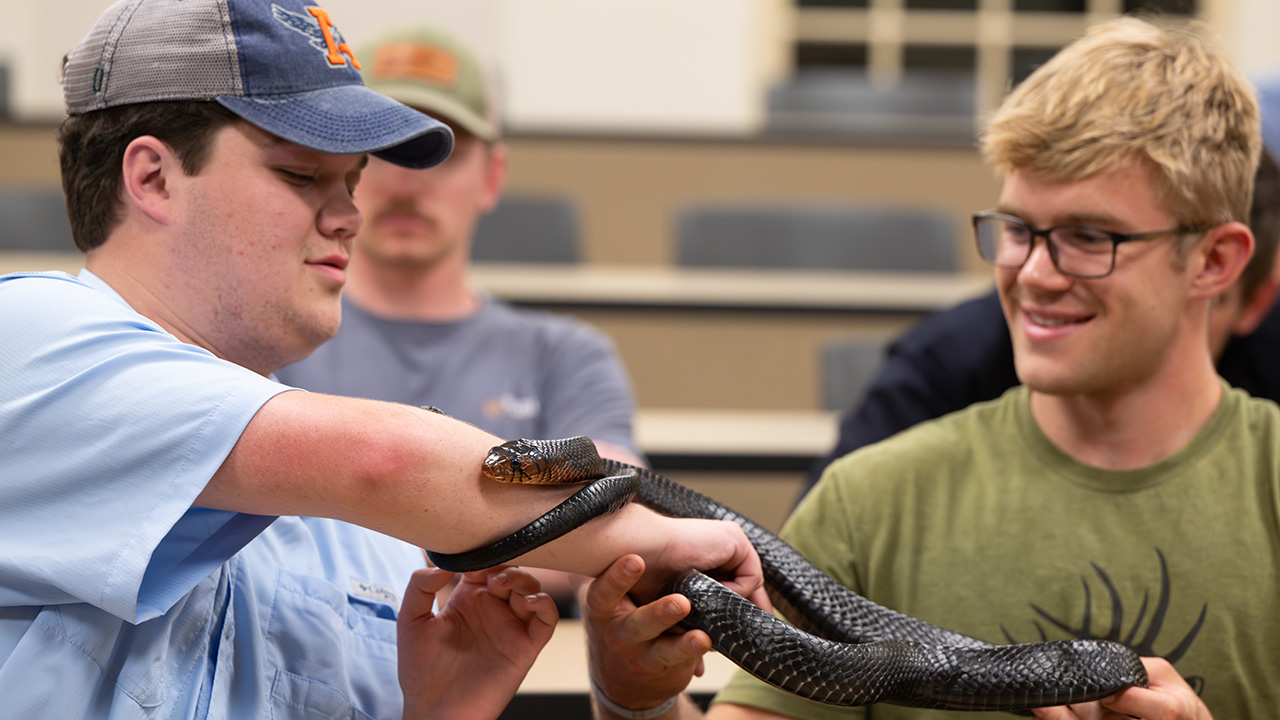content body
After a long day of identifying trees and wildlife in the heat and humidity, Auburn University students just want a good meal and an air-conditioned place to rest their heads.
So, where can they find comfortable accommodations in the middle of an Alabama forest? They’ll find them at the Solon Dixon Forestry Education Center.
The Solon Dixon Center, a facility run by the College of Forestry, Wildlife and Environment (CFWE), is located near Andalusia in Covington and Escambia counties in south Alabama. Donated to the university by Solon and Martha Dixon, the center is home to dorms, a dining hall, auditoriums, classrooms and conference space surrounded by more than 5,000 acres of forest. For students studying forestry and wildlife sciences, completing long days of summer practicum there is both a rite of passage and a graduation requirement.
“It’s a chance to get the students out in the field to do stuff you just can’t do on campus, even in labs,” said Associate Dean for Academics Todd Steury, who teaches at summer practicum each year. “It’s very hands-on.”
Walking in the woods
For students majoring in forestry, summer practicum serves as their introduction to the program. As pre-forestry students, they spend the first two years of college completing core requirements and forestry prerequisites and then apply to be accepted into practicum the summer before their junior year. They complete 11 credits over nine weeks at Solon Dixon in subjects including tree identification and health, forest biology, surveying and management.
“They’re learning everything there is to know about growing and harvesting trees,” Steury said. “They start with a lecture at 8 a.m., and then they’re out in the field through lunch. They come back late in the afternoon and sometimes have classes in the evenings, so it’s pretty intense.”
Squirrels and lizards and bears, oh my!
While forestry students are just getting started on their major coursework, students studying wildlife ecology and management are preparing for their final year of college at summer practicum. They take a single class worth eight credits taught by several different instructors, and their days are just as long and challenging as those of the forestry students.
The wildlife students start each day out in the field at 5 a.m., observing bird calls or trapping mammals. After breakfast, they learn about techniques for collecting data on animals and vegetation, then head to the lab to practice writing scientific reports while avoiding the midday heat. In the evening, they head back out to the woods to set traps or do more fieldwork.
Both faculty and outside experts share techniques the students could never learn on Auburn’s main campus. Faculty member Stephen Ditchkoff shows how to trap deer with a canon net, and Steury leads students on a trip to Mobile to learn about capturing bears.
“They do get practice doing radiotelemetry, where you put a collar on an animal for tracking — that takes some skill, so this is a chance for them to practice,” he said. “We use aquatic traps to catch snakes and lizards and turtles, pitfall traps to catch frogs and salamanders and Sherman traps to catch flying squirrels. You’d never know they’re everywhere down there because you never see them, but our students get to release them and watch them go back up the tree to do their flying thing.”
A facility for all
Joel Martin, director of the center, says Solon and Martha Dixon had a vision of creating a place where anyone interested in managing natural resources could learn by doing.
“He wanted them to be able to experience their book learning in a field setting,” Martin said. “He created a place which provides that experience on a larger scale than can be replicated in most situations.”
While its primary function is to act as a field station for Auburn students, the Solon Dixon Center is open for anyone to use, including school groups, government organizations and corporate retreats. Each year, the U.S. Forest Service uses Solon Dixon as its East Coast training center for the National Wildland Firefighter Apprentice Program for about three months, and the Alabama Forestry Commission visits for eight weeks to train employees on forest management and equipment operation.
“Outside of these two groups, we get herpetologists, ornithologists, botanists and every other type of ‘-ologists’ you can name that come here to do exactly what Mr. Dixon envisioned some 44 years ago,” Martin said. “We provide the hands-on opportunities these groups are seeking to better expand their learning opportunities.”
But at the end of the day, Solon Dixon is a home away from home for Auburn students acquiring many of the most important skills they’ll need in their careers. Rick Oates, the Alabama Forestry Commission's state forester, has hired plenty of CFWE graduates, and he says their time at Solon Dixon is one reason they’re so highly qualified.
“The experience they get from attending summer practicum makes them much better prepared candidates for the forestry jobs we offer,” Oates said. “It’s where classroom theory meets practical forestry and gives them an edge when it comes to their knowledge and ability to work in the woods.”
What’s it like to stay at Solon Dixon Center?
Take a look at pictures of the lodging, dining facilities, classrooms and more















